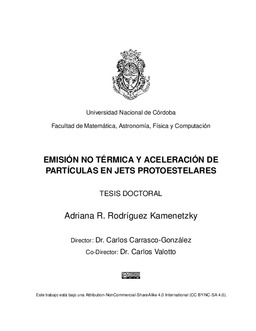| dc.contributor | Valotto, Carlos ALberto, co dir. | |
| dc.contributor.advisor | Carrasco González, Carlos, dir. | |
| dc.contributor.author | Rodríguez Kamenetzky, Adriana Raquel | |
| dc.date.accessioned | 2019-08-07T14:31:13Z | |
| dc.date.available | 2019-08-07T14:31:13Z | |
| dc.date.issued | 2018 | |
| dc.identifier.uri | http://hdl.handle.net/11086/11763 | |
| dc.description | Tesis (Doctor en Astronomía)--Universidad Nacional de Córdoba, Facultad de Matemática, Astronomía, Física y Computación, 2018. | es |
| dc.description.abstract | Desde los primeros estudios realizados en radiofrecuencias en regiones de formación estelar, la emisión de jets de objetos estelares jóvenes (YSOs, por sus siglas en inglés) ha sido considerada exclusivamente de origen térmico. La presencia de una componente de emisión no térmica en jets protoestelares, constituye un descubrimiento reciente y sin dudas excepcional, que implica la existencia de partículas con velocidades relativistas en interacción con campos magnéticos. Explicar la presencia de tales partículas en estos sistemas, requiere la acción de un mecanismo responsable de incrementar eficientemente su energía cinética.
El principal objetivo de esta Tesis es profundizar en la investigación de este interesante tópico. Para ello se estudió la emisión continua en radio de dos YSOs con distinta masa: (1) La fuente triple en radio continuo en Serpens (masa intermedia), el primer YSO para el cual ha sido propuesta la presencia de emisión sincrotrón y que, morfológicamente, puede considerarse el prototipo de jet protoestelar no térmico; (2) El sistema HH 80-81 (alta masa), uno de los jets protoestelares más potentes conocidos, y el único (hasta el momento) en que se ha detectado emisión centimétrica linealmente polarizada, confirmando el origen sincrotrónico de la radiación. En ambos casos, se realizaron estudios para caracterizar la naturaleza de la emisión en radio en distintas regiones del jet. Los resultados fueron analizados en el contexto de aceleración de partículas en choques del jet con el medio ambiente, explorando los posibles escenarios en que éstas podrían ser eficientemente aceleradas a energías relativistas. El estudio de estos objetos fue abordado en un amplio rango de longitudes de onda de radio, mediante el análisis de nuevos datos de alta sensitividad obtenidos con interferómetro Karl G. Jansky Very Large Array (VLA) del National Radio Astronomy Observatory (NRAO). | es |
| dc.description.abstract | Since the first studies of star formation regions at radio frequencies, the emission of jets powered by young stellar objects (YSOs) has been exclusively considered of thermal origin. The presence of a non thermal component in the radio emission of these jets constitutes a recent discovery with very importan implications, such as the existence of particles with relativistic velocity interacting with magnetic fields. The existence of relativistic particles in these low energy systems requires the action of a mechanism able to efficiently increase their kinetic energy.
The main goal of this Thesis is to deepen the study of this interesting topic. For this purpose we studied the radio continuum emission of two representative YSOs having different masses: (1) The triple source in Serpens (intermediate mass), known to be first YSO for which the presence of synchrotron radiation has been proposed, and morphologically considered as a prototype of non-thermal jets; (2) The system HH 80-81 (high mass), being one of the most powerful protostellar jets known, and the only one (to date) for which linearly polarized centimeter emission has been detected, thus confirming the synchrotronic origin of the radiation. In both cases, studies were conducted to characterize the nature of the radio emission in different regions of the jet. The results were analyzed in the context of particle acceleration in the shocks of the jet with the environment, exploring possible scenarios to accelerate particles up to relativistic energies. We addressed the study of these objects through the analysis of new high sensitivity data obtained with the Karl G. Jansky Very Large Array (VLA) interferometer from the National Radio Astronomy Observatory (NRAO), in a wide range of radio wavelengths. | en |
| dc.language.iso | spa | es |
| dc.rights | Atribución-NoComercial-CompartirIgual 4.0 Internacional | * |
| dc.rights.uri | http://creativecommons.org/licenses/by-nc-sa/4.0/ | * |
| dc.subject | Mecanismos de radiación | es |
| dc.subject | Interferometría | es |
| dc.subject | Procesamiento de imágenes | es |
| dc.subject | Formación de estrellas | es |
| dc.subject | Radiation mechanisms | en |
| dc.subject | Radio telescopes and instrumentation | en |
| dc.subject | Interferometry | en |
| dc.subject | Image processing | en |
| dc.subject | Star formation | en |
| dc.subject | Jets, outflows, and bipolar flows | en |
| dc.subject | Cosmic rays | en |
| dc.subject.other | Jets protoestelares | es |
| dc.subject.other | Emisión continua en radio | es |
| dc.subject.other | Emisión sincrotrón | es |
| dc.subject.other | Indice espectral | es |
| dc.subject.other | Aceleración de partículas | es |
| dc.title | Emisión no térmica y aceleración de partículas en jets protoestelares | es |
| dc.type | bachelorThesis | es |





